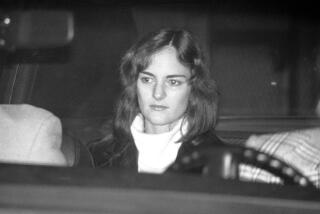Other Crimes Can Be Cited at Olson Trial, Judge Rules
- Share via
The 1976 indictment against Sara Jane Olson accuses her of plotting to plant pipe bombs under police cars, but a Los Angeles Superior Court judge said Monday that prosecutors can show jurors evidence of nearly two dozen other crimes--including two murders and a kidnapping.
Judge James M. Ideman gave Deputy Dist. Attys. Eleanor Hunter and Michael Latin the green light to delve into details of 23 crimes attributed to the notorious Symbionese Liberation Army during its violent, 22-month campaign. The prosecutors say they can prove that Olson, then known as Kathleen Soliah, was an enthusiastic member of the group.
Olson’s defense had objected to the evidence of other crimes, saying that it is inflammatory. Attorney Susan Jordan argued that in many instances, no one has been charged with the crimes. Soliah denies having been an SLA member.
The trial, likely to provide a history lesson on the turbulent politics of the 1970s, will not be televised. Ideman refused Monday to let Court TV and CNN bring television cameras into his courtroom.
“I believe, along with most of my colleagues, that televising trials can be a bad thing,” he said. “I’m ag’in’ it. I admit my bias.”
The judge said cameras in the courtroom change the way witnesses and lawyers act. A key factor in denying cameras, Ideman said, was his reluctance to force the prosecution’s key witness, SLA kidnap victim Patricia Hearst Shaw, to relive her experiences on live television.
In his ruling, the judge accepted without question the newspaper heiress’ often-disputed testimony that she was tortured, raped and kept in a closet for 57 days.
“To make her go through all that again [on live television] would be like raping her all over again,” Ideman said. He added that he was “not going to allow” her to take the stand “with the whole country hanging on everything that comes from her lips.”
Hearst, who was 19 when she was kidnapped by the SLA, eventually converted to her captors’ cause, taking the code name “Tania.” She was convicted in 1976 of an SLA armed robbery and is seeking a presidential pardon. She has expressed reluctance to testify in the Olson matter.
Other witnesses--especially her chief captors, William and Emily Harris--have denied that Hearst was mistreated and say she willingly joined the SLA.
“I can tell you she was not abused,” Bill Harris said in an interview last month. “She wasn’t raped.”
Emily Harris, his former wife, claimed that Hearst said she was raped only after her arrest.
“There was a lot of pressure from her family and public opinion was against her,” Emily Harris said last month. “She had to prove emphatically that she was a victim.”
Hearst herself has said that as a convicted felon she would not make a very credible witness. The jury at her 1976 bank robbery trial did not believe her story and convicted her.
By allowing prosecutors to present a history of the SLA, the judge said, they can corroborate Hearst’s testimony.
It’s unclear just what Hearst might say.
Defense attorney Stuart Hanlon said in court that “it’s common knowledge in the legal community” that no one involved in the Olson case has interviewed Hearst.
Ideman did hand the defense one victory, ruling that the grand jury testimony of a dead plumbing supply clerk could not be used at Olson’s trial. The identification of Olson by clerk James Marshall was “not reliable,” because he described a short woman with a plump face and large hips. Olson is tall and thin.
But if the dead man isn’t talking, neither are any of the other key players. Ideman issued a gag order for Olson, the lawyers and all witnesses.
Olson was indicted for conspiracy to commit murder in 1976 and was a fugitive until last year, when she was arrested a few blocks from her home in Minnesota, where she had built a life as a doctor’s wife, mother and community activist. She is free on $1-million bail.
The trial is to begin Feb. 7.
More to Read
Sign up for Essential California
The most important California stories and recommendations in your inbox every morning.
You may occasionally receive promotional content from the Los Angeles Times.












